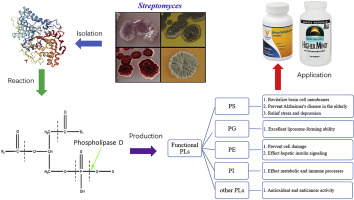Trends in Food Science & Technology ( IF 15.3 ) Pub Date : 2019-12-24 , DOI: 10.1016/j.tifs.2019.12.020 Zhenxia Zhang , Ming Chen , Wei Xu , Wenli Zhang , Tao Zhang , Cuie Guang , Wanmeng Mu

|
Background
Phospholipids (PLs) are major components of biological membranes in all living organisms and have been widely applied in the food, pharmaceutical and cosmetic industries for their numerous nutritional and bioactive functions. Traditionally, PLs have been extracted from egg yolk and soybean using organic solvents; however, the high cost of purification poses a limitation for their further application.
Scope and approach
Recently, growing attention has been paid to the biological production of PS using phospholipase D (PLD, EC 3.1.4.4). PLD, belonging to PLD superfamily, can catalyze both the hydrolysis of phosphatidylcholine (PC) to phosphatidic acid (PA) and the transphosphatidylation of PC to PL when an appropriate acceptor alcohol is provided. Transphosphatidylation plays a critical role in preparation of functional PLs.
Key findings and conclusions
To date, approximate 9 genera of microorganisms have been identified and used to prepare PLD. The overall crystal structure PLD and a two-step reaction mechanism have been proposed. In addition, examples of successful modification of PLD such as altering substrate specificity, enhancing thermostability and improving activity have been discussed. In the future, research aimed at searching for novel PLDs with a higher transphosphatidylation activity, determining the crystal structure of more PLDs, and improving the catalytic performance of PLDs through a rational design for the production of PLs should be conducted. Last but not least, more novel and biodegradable solvents for the production of PLD are essential for their further application in daily use.
中文翻译:

微生物磷脂酶D:鉴定,修饰和应用
背景
磷脂(PLs)是所有活生物体中生物膜的主要成分,由于其众多的营养和生物活性功能,已被广泛应用于食品,制药和化妆品行业。传统上,PL是使用有机溶剂从蛋黄和大豆中提取的。然而,纯化的高成本限制了它们的进一步应用。
范围和方法
近来,使用磷脂酶D(PLD,EC 3.1.4.4)的PS的生物生产已得到越来越多的关注。当提供适当的受体醇时,属于PLD超家族的PLD既可以催化磷脂酰胆碱(PC)水解为磷脂酸(PA),又可以催化PC转化为PL。转磷脂酰化在功能性PL的制备中起关键作用。
主要发现和结论
迄今为止,已经鉴定出大约9种微生物,并用于制备PLD。已经提出了整体晶体结构PLD和两步反应机理。另外,已经讨论了成功修饰PLD的实例,例如改变底物特异性,增强热稳定性和改善活性。将来,应该进行旨在寻找具有更高的转磷脂酰化活性的新型PLD,确定更多PLD的晶体结构以及通过合理设计PL的生产来改善PLD催化性能的研究。最后但并非最不重要的一点是,用于PLD生产的新型和可生物降解的溶剂对于它们在日常使用中的进一步应用至关重要。


























 京公网安备 11010802027423号
京公网安备 11010802027423号